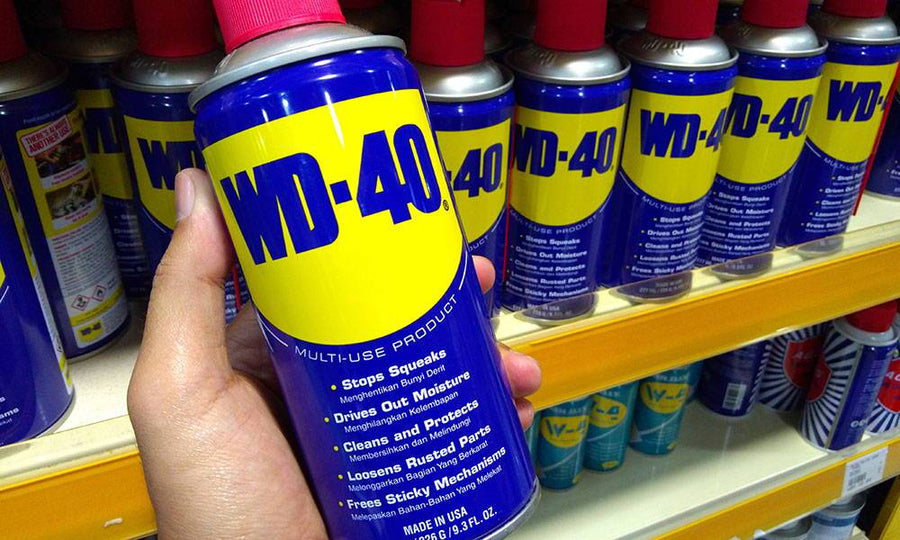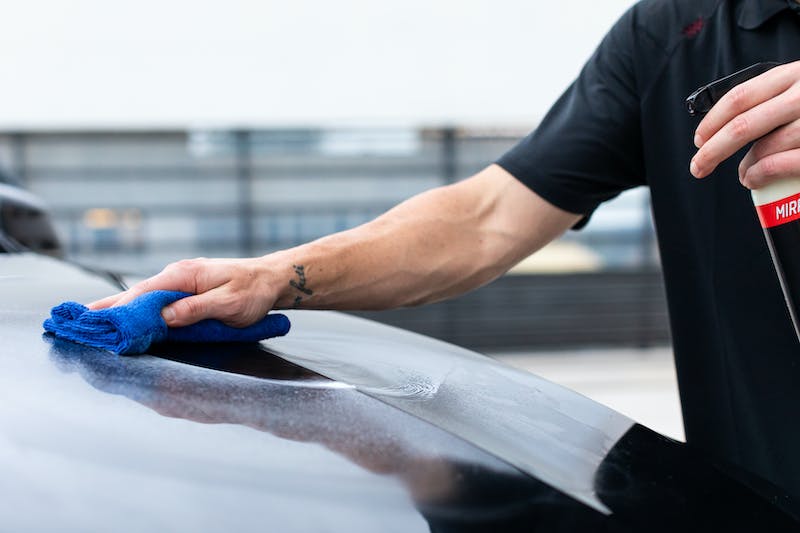No, WD-40 is not bad for car paint as it is safe to use on most car surfaces. WD-40 is a versatile lubricant that can be used for various purposes, including removing adhesive residue, tar, bugs, and even minor scratches on the car paint.
It is important, however, to use WD-40 sparingly and with caution, as excessive use or rubbing can lead to damage or discoloration of the paint. It is always recommended to test WD-40 on a small, inconspicuous area of the car before applying it to the entire surface.
Additionally, it is advisable to clean the treated area thoroughly after using WD-40 to avoid any potential negative effects on the car’s appearance.

Credit: avalonking.com
What Is Wd-40?
WD-40 is a versatile and popular product that has a wide range of uses. Originally developed by the Rocket Chemical Company in 1953, WD-40 stands for “Water Displacement, 40th formula.” Its main purpose was to prevent corrosion on the outer skin of the Atlas missile. Over the years, WD-40 has become a household name and is now commonly used for various tasks, including lubrication, rust removal, and loosening stuck parts.
WD-40 is composed of several ingredients, including a petroleum-based solvent, mineral oil, and various additives. This unique combination gives WD-40 its ability to protect metal surfaces from rust and corrosion, as well as its lubricating properties.
How Is Wd-40 Used In Automotive Applications?
WD-40 is a popular choice among car enthusiasts for its versatility in automotive applications. It can be used for a variety of tasks, ranging from lubricating moving parts to removing stubborn residue. Here are some common uses of WD-40 in the automotive context:
- Lubricating door hinges, locks, and latches: WD-40 can help keep these components moving smoothly, preventing squeaks and ensuring reliable operation.
- Removing tar and grime: WD-40 can effectively dissolve and remove sticky substances like tar and grime from your car’s exterior surfaces.
- Protecting against rust: Applying WD-40 to metal surfaces can provide a barrier against moisture and protect against rust and corrosion.
- Loosening rusted or stuck parts: WD-40’s penetrating properties can help loosen stubborn bolts, nuts, and other components that have become corroded over time.
While WD-40 can be a useful tool in automotive maintenance, it’s important to use it responsibly and with caution, especially when it comes to your car’s paint. In the next section, we will delve deeper into the topic of whether WD-40 is bad for car paint and consider the factors you need to keep in mind.

Credit: www.torquedetail.com
Effects Of Wd-40 On Car Paint
When it comes to maintaining the exterior of your car, one of the most important considerations is protecting the paint. A good way to prevent damage is by being cautious about the products you use.
WD-40 is a versatile product that many people have in their homes. But does WD-40 harm car paint? In this section, we will explore the effects of WD-40 on car paint and debunk some common misconceptions.
There is a common misconception that WD-40 will damage car paint. However, this is not entirely true. WD-40 is formulated to be a lubricant and protectant, and when used correctly, it can help maintain the appearance of your car.
Factors That Contribute To Damage
While WD-40 itself may not harm car paint, several factors can contribute to damage if not used with care. Some of these factors include:
- Using too much pressure: Applying excessive force when using WD-40 can cause the paint to become scratched or dull.
- Not following the instructions: Like any product, it’s essential to read and follow the instructions provided by the manufacturer. Using WD-40 in a manner that goes against these instructions can lead to unintended consequences.
- Leaving it on for too long: WD-40 should be used as a temporary solution and should not be left on the paint for an extended period. If left on for too long, it can cause the paint to become discolored or damaged.
Common Misconceptions About Wd-40 And Car Paint
There are a few common misconceptions about WD-40 and its effects on car paint. Let’s take a closer look at them:
- WD-40 removes scratches: While WD-40 can help to hide the appearance of light scratches temporarily, it will not remove them. It is always recommended to use appropriate products designed specifically for scratch removal.
- WD-40 protects against UV damage: WD-40 is not designed to protect your car’s paint from UV damage. It is advisable to use a dedicated car wax or paint sealant for long-term protection against harmful UV rays.
- WD-40 is a substitute for car wax: Although WD-40 can provide temporary shine and protection, it is not a substitute for high-quality car wax. Car wax is specifically formulated to provide long-lasting protection and enhance the overall appearance of your vehicle.
| Myth | Fact |
|---|---|
| WD-40 removes scratches | WD-40 can only temporarily hide scratches |
| WD-40 protects against UV damage | WD-40 does not provide long-term UV protection |
| WD-40 is a substitute for car wax | Car wax offers better and longer-lasting protection compared to WD-40 |
Protecting Car Paint From Damage
Protect your car paint from damage by avoiding the use of WD-40. This common household product can harm your car’s paint job, leading to costly repairs. Stick to approved car care products to ensure the longevity of your vehicle’s exterior.
Your car’s paint is like its protective armor, shielding it from the elements and giving it a sleek, polished appearance. But maintaining that pristine shine can be a challenge, especially when it comes to preventing damage caused by harsh substances.
One such substance that often raises concern is WD-40. While WD-40 is renowned for its versatility and ability to lubricate, it’s important to understand whether it’s safe to use on your car’s paint.
Preventive Measures To Avoid Paint Damage
Prevention is always better than cure when it comes to protecting your car’s paint. By taking a few simple precautions, you can minimize the risk of damage and prolong the life of your car’s paint job. Here are some preventive measures you can take:
- Regularly wash your car using a mild car soap and a soft microfiber cloth.
- Avoid parking your car under trees or near construction sites where it may be exposed to sap, bird droppings, or debris.
- Apply a protective wax or sealant to create a barrier against the elements.
- Invest in a quality car cover to shield your vehicle from dust, UV rays, and weather damage.
Alternative Products For Paint Care
If you’re concerned about using WD-40 on your car’s paint, there are alternative products available that are specifically formulated for paint care. These products are designed to clean, polish, and protect your car’s paint without causing any damage. Some popular alternatives include:
| Product | Description and Benefits |
|---|---|
| Carnauba Wax | A natural wax that provides a deep shine and long-lasting protection against UV rays and contaminants. |
| Polymer Sealant | A synthetic sealant that forms a durable barrier, shielding your car’s paint from oxidation, fading, and environmental damage. |
| Ceramic Coating | A high-performance coating that offers superior gloss, scratch resistance, and long-term protection against UV rays, chemical stains, and more. |
Proper Methods To Use Wd-40 Safely On Cars
If you still decide to use WD-40 on your car’s paint, it’s crucial to follow the proper methods to ensure its safe application and minimize any potential damage. Here are a few guidelines to keep in mind:
- Test a small, inconspicuous area of your car’s paint before applying WD-40 to the entire surface.
- Apply WD-40 to a clean microfiber cloth, and gently wipe the affected area in a circular motion.
- Avoid letting WD-40 come into contact with plastic trim, rubber seals, or any non-paint surfaces.
- After applying WD-40, thoroughly wash and rinse the area with mild car soap and water.
- Reapply a protective wax or sealant to restore shine and provide an extra layer of protection.
By adhering to these proper methods, you can minimize the risks associated with using WD-40 on your car’s paint and help maintain its appearance for years to come.
Final Words
Overall, it is important to exercise caution when using WD40 on car paint. While it may provide temporary benefits in terms of cleaning and removing stubborn stains, it can also potentially cause damage to the paint’s clear coat over time.
It is recommended to test the product on a small, inconspicuous area before applying it to the entire surface. Additionally, regular maintenance with specialized automotive products is highly advisable to ensure the longevity and protection of your car’s paintwork.

